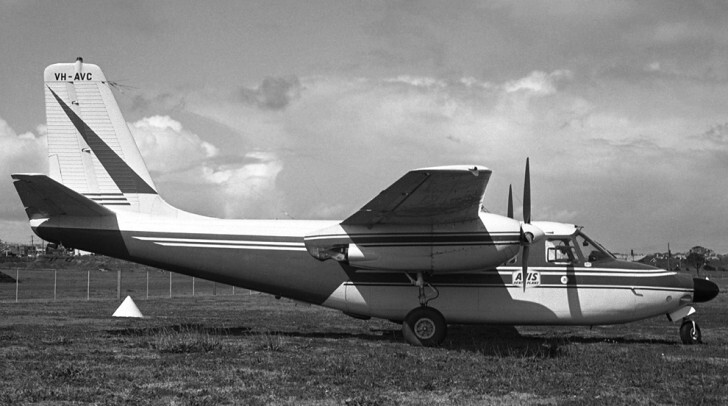By Barry Collman
First published in Flight Levels Online, Fall 2013 issue

The 680 “Super” Commander was the fourth model to be placed into production. The first 254 were built by the Aero Design & Engineering Company at Tulakes Airport (later renamed Wiley Post) in Bethany just west of Oklahoma City, Oklahoma, and the last one by the Aero Design & Engineering Company as a subsidiary of the Rockwell-Standard Corporation.
All 255 680 Supers were built between August 1955 and October 1958, with serial numbers in the range 680-242-1 through 680-658-255. Of these, two were initially certified in 1955; 128 in 1956; 98 in 1957; and 27 in 1958.
Many sources quote the number built as 252; that number fails to account for the the fact that three Models 680s were later converted to other models and given new serial numbers. Serial number 680-501-171 was converted to 680E configuration in 1957 and then to the first Model 720 “Alti-Cruiser.” Later that year it was given s/n 720-501-1.
Serial Number 680-242-1 was converted to a 680E and in May 1958 became s/n 680E-242-102. Serial Number 680-624-250 was converted to a 680E and became s/n 680E-624-9 in August 1958 while owned by Ted Smith.
In addition, 35 680s were later converted to 680Es, but were not given new serial numbers, according to Aero Commander Report G10-163.

The U.S. Army purchased this Commander, s/n 680-466-136, gave it the designation RL-26D, and took possession of it on October 21, 1957. Because of the large, bulbous nose radome the nose gear had to be moved aft, from Station -27.00 to -7.25, and certain revisions had to be made in the retracting mechanism and the supporting structure. It was assigned to the Army’s Signal Corps at Fort Huachuca, Libby Field, Arizona. The image was taken by Bude Donato at Van Nuys, California, on October 15, 1968.
A factory document describes the Model 680, under Wing Drawing 5170023, as “certified to CAR 3 Amendment 12 on December 14, 1955. This model was created by changing the Model 560A by increasing the gross weight to 7,000 pounds and changing the engines to Lycoming GSO-480-A1A6 engines. In 1957 the engines were changed to Lycoming GSO-480-B1A6.”
The Model 680 was certified on October 14, 1955, according to a new Type Certificate, Number 2A4, initially created for supercharged engine models. Note the discrepancy between the certification date quoted earlier in a factory document as “December 14, 1955.”
The first 229 examples of the Model 680 had Lycoming GSO-480-A1A6 engines, while the last 26 had the GSO-480-B1A6s; both engine models had a takeoff rating of 340 hp. All used the 93-inch-diameter Hartzell HC-83X20-2C/9333C propeller, with the exception of s/n 680-483-153, which had the HC-83X20-2C1/9333C variant. The -B1A6 engine has crankcase oil jets for increased piston cooling, provisions for a supercharger inlet, and an updraft carburetor. The engine’s type certificate says that “the oil cooler outlet gills must be relocated in accordance with Service Letter No. 62 and oil temperature gauge markings changed per Service Letter No. 63.”
Visually, the Model 680 is indistinguishable from the Model 560A.
The U.S. Air Force ordered 15 Model 560As under military designation L-26B, but when the Model 680 became available the last two 560As were changed to the Model 680 and designated L-26C. These were used by President Eisenhower as the more powerful and supercharged engines were deemed to offer an even greater safety aspect.
On July 5, 1957 Miss Geraldyn M. “Jerrie” Cobb established a world altitude record while flying N6226D, s/n 680-490-160. The Federation Aeronautique Internationale shows the height as 9,254 meters, which calculates to 30,360 feet, but in the 1957-58 and 1958-59 editions of Jane’s All The World’s Aircraft the height is given as 30,330 feet (9,244.6 meters).
When two Model 680s were delivered to the U.S. Army late in 1957 and designated as RL-26D, they had SLAR equipment mounted along the sides of the fuselage, blocking the cabin entrance door. For this reason the “forward cabin door,” as the factory called it, or the “front cabin door” as used on STCs, came into use. Available as an option on later-build models, it became a standard item by the time the Model 500S “Shrike” went into production.
These RL-26D aircraft also had a large, bulbous nose housing radar equipment that required the nose gear to be moved aft, from station -27.00 to -7.25. Certain revisions also were made in the nose gear retracting mechanism and supporting structure. Also, the landing lights were relocated into the underside of each wing and were electrically operated.
Barry Collman’s lifelong interest in airplanes began when he was growing up in a house located underneath the downwind leg to busy Northolt aerodrome, an R.A.F. base near London-Heathrow airport. As a young teenager he discovered airplane “spotting” –– hobbyists’ observation and logging of aircraft by make, model, and registration number. The hobby began to grow into a passion as Collman joined a club of like-minded spotters. At one point he purchased a copy of the January 1966 U.S. Civil Aircraft Register, and thumbing through it came upon the Aero Commander. He was hooked. Eventually he acquired every available FAA microfiche file on Commanders, and since 1995 has made annual pilgrimages to Oklahoma City to sift through FAA records. He now has a database with more than 96,100 records as well as a collection of negatives, slides, photographs, digital images, magazines, brochures, knick-knacks –– and a very understanding wife. This series on Commander production history originally was written for the Twin Commander Flight Group, of which he is an enthusiastic member.
